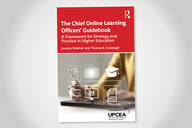You have /5 articles left.
Sign up for a free account or log in.
For a number of years, we have been advocating for companies in the online program management space to support independent research on institutional and student outcomes associated with nonprofit/for-profit partnerships.
We are therefore gratified when one of those OPM leaders whom we have been trying to influence in making this case agreed to talk through some ideas in this space.
As 2U’s chief strategy and engagement officer, David Sutphen is well positioned to address any concerns that OPMs may have in supporting independent research, while also able to commit resources to these sorts of efforts if persuaded. We are grateful to David for being willing to make this conversation transparent and open.
Q: In our previous discussions about the need for independent, data-driven research on OPM outcomes, you were supportive but expressed some concerns. Chief among your hesitations was the challenge of getting outcome data (from schools and students) from both other OPMs beyond 2U, and from schools that are running online programs with in-house resources. Can you elaborate on your concerns, and maybe share some ideas on how to overcome these obstacles?
A: First, thank you for the opportunity to discuss this important topic. I appreciate the venue and the openness with which you’re approaching these questions. I remember our conversations well. At the time, 2U and others in our space were frustrated at the lack of available data and research, beyond what we collect and analyze in-house, that could give us more definitive insight into how students enrolled in online higher education programs were persisting, graduating and having positive career outcomes.
The reality is, before we can determine what these outcomes look like for OPM-powered courses versus the larger landscape of online programs, we need better outcomes data on online versus traditional residential programs more broadly. For the most part, this doesn’t exist, and it’s an impediment to our collective understanding of the challenges and opportunities in online learning. OPM partnerships remain a growing but still relatively small part of the industry. So while it’s important to ask questions about the outcomes and quality of OPM-supported programs, as a policy matter, we have larger questions to answer, particularly at a critical moment as institutions continue to rethink (and in many cases begin) their digital transformation journey.
To get at the heart of this issue, about a year ago, 2U and others in our space approached University of Tennessee at Knoxville professor and independent research scholar Robert Kelchen to find and analyze data on online learning outcomes from OPM partnerships. He recently published his findings and wrote about them for Inside Higher Ed—his conclusion is, essentially, that there is no way to determine student outcomes in OPM-supported online programs versus other online programs, nor online programs in general regardless of partnership models, using currently available College Scorecard and IPEDs data. He also makes some helpful policy recommendations to solve this, which we’re in full support of.
As we’ve shared with you before, we’re serious about data transparency and will continue to be as we grow with edX. 2U was the first OPM to publish a transparency framework and annual transparency reports that include outcomes for our partners’ online programs (we’ve done two so far, with more to come) and commission research with Gallup to study the outcomes of our programs (we’ve also published two of these studies, with more to come). From our own interactions with partners and their students, we see the positive impacts we have on people’s lives, but we also recognize that more work needs to be done to foster even greater transparency around outcomes. And we’re committed to that work.
Q: Do you have thoughts on the question of where the research infrastructure around nonprofit/for-profit partnerships should be built? Should it live within a university? Or should 2U create an independent research group within the company? What do you see as the pros and cons of each approach?
A: We believe the recent analysis conducted by Robert Kelchen in partnership with other ed-tech companies is a good model, because he maintained complete control over the data analysis.
Before we think about doing more independent research like this, it seems clear from Kelchen’s findings that we first need better publicly available data. Without that, it’s exceedingly difficult to answer the kinds of questions you’ve posed, because the necessary data is either not available or is inconsistent across institutions in ways that inhibit apples-to-apples comparisons.
We’re looking into helping our partners do more of this work, for example by supporting MIT and Harvard’s nonprofit the Center for Reimagining Learning, as well as the University of North Carolina at Chapel Hill’s Digital Education Research Hub.
Q: What do you see as the highest-priority questions research should address? Do you think the unit of analysis (at least for initial research) should be institutional outcomes (the impact of OPM vs non-OPM partnerships on universities) or individual learners (such as graduation, debt, income, etc.)? What research would you like to see?
A: I’d be most interested in seeing research analyzing the three-, five- and 10-year impact of both online and on-campus degree and nondegree programs on the lives of learners across a multitude of factors: income growth, overall happiness, career satisfaction, debt levels, continued education pathways and beyond. Some studies of postgraduate earnings stop at the one-year mark, which, for many fields, doesn’t allow adequate time to measure career satisfaction, which can include factors other than just earning potential.
Gallup just released a blog post on the ROI of the boot camps we power with universities, and the findings are compelling—one year after their graduation, the median salary for all boot camp graduates surveyed was $11,000 higher than what they said they were earning while they attended boot camp. Among graduates employed full-time in both years, median salaries rose from approximately $59,000 during boot camp to $70,000 after boot camp. The median income growth was 17 percent.
Having more independently verified longitudinal studies on the postgraduate outcomes of degree and boot camp students in the online space, irrespective of whether those students attended an OPM-supported program, would also be enormously valuable. However, as Kelchen points out, for degree-granting programs, that starts with better data collection by colleges and universities at the front end for all learning modalities, and it may also require improved data-collection efforts by the federal government so that outcomes data is more readily available to the public. Ultimately, better data will benefit students and create informed policy.




